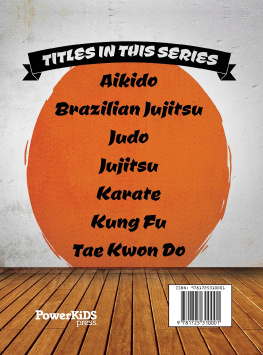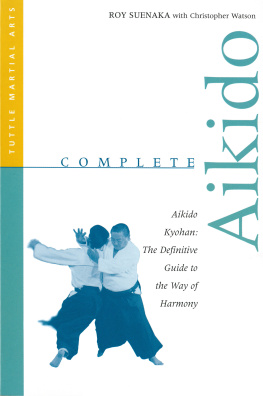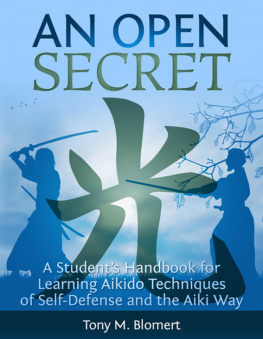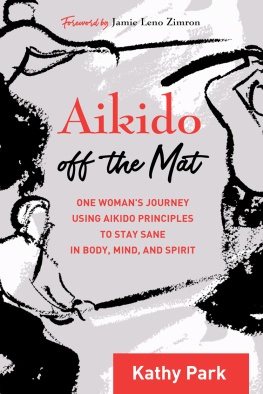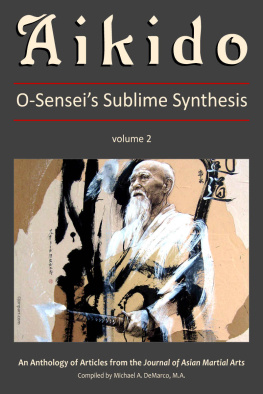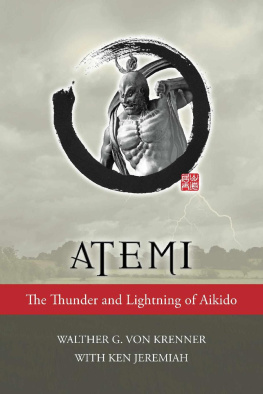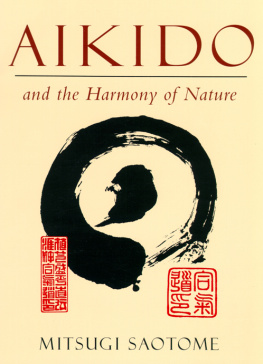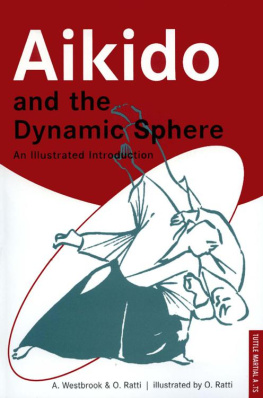Acknowledgments
T HE SOURCES of direct and indirect assistance to the authors in the process of collecting the material for Aikido and the Dynamic Sphere are too many to be acknowledged individually here. In the former category, for example, are all those instructors and advanced students of the art, scattered throughout the world, under whose personal guidance the authors explored the practical dimensions of this Discipline of Coordination, or with whom they practiced and corresponded for years. In particular, however, they wish to express their personal gratitude to Yasuo Ohara, who introduced them to aikido for the first time in New York in 1962; to Edi Hagihara, Barry Bernstein, and Virginia Mayhew, who helped them overcome many difficulties during their "apprenticeship" period; to Walter N. Dobson, Motokage Kawamukai, and Yoshimitsu Yamada, who clarified many problems of technical application and style; to Koichi Tohei, chief instructor at Hombu Dojo in Tokyo whoin April, 1965conferred upon them the rank of black belt, 1st degree; and to Kisshomaru Uyeshiba, son of the founder of aikido, who instructed them during his brief visit to New York in 1966.
The authors are not listing individually, by name and rankbut do remain deeply indebted toall those other instructors and advanced students in the United States (from the East Coast to the West Coast, and Hawaii), in Japan, France, Italy, and Belgium who illustrated and explained their particular methods and technical interpretations of aikido, either personally or in lengthy correspondence.
Styles of performance are as many and as unique as the individuals who practice an artaikido being no exception. Each and every one to which the authors were exposed offered them an opportunity to view various aspects of the practice in a new light and to re-examine their own basic premises.
The sources of indirect assistance, invaluable moral support and encouragement include in particular Dr. Elizabeth Richards and Mr. Charles G. Partington; Edward M. Kinney, Edward O'Brien, Anthony Foddai, and Edvi Illes Gedeon.
Finally, the authors wish to express their heartfelt gratitude to all those aikido practitioners with whom they were privileged to practice in the United States, France, and Italy, and to those students at all levels of development who willingly cooperated in the testing and refining of the authors' theories on the tatami in dojo all over the world.
Last, but certainly not least, we wish to express our appreciation to the members of the Editorial and Design departments of the Charles E. Tuttle Company for their patient and painstaking efforts on behalf of Aikido and the Dynamic Sphere.

Selected Bibliography
| I | ON THE HISTORICAL AND PHILOSOPHICAL FOUNDATIONS OF AIKIDO |
Anesaki, Masaharu: History of Japanese Religion, Tokyo, 1963 |
Brinkley, Captain F.: Japan, Boston, 1902 |
Ch'u Chai and Winberg Chai (trans, and ed.): The Humanist Way in Ancient China: Essential Works of Confucius, New York, 1965 |
Creel, H. C.: Chinese ThoughtFrom Confucius to Mao-Tse-Tung, Chicago, 1953 |
Coomaraswamy, Ananda K.: Buddha and the Gospel of Buddhism, London, 1916 |
Demoulin, Heinrich: A History of Zen Buddhism, New York, 1963 |
Hearn, Lafcadio: JapanAn Attempt at Interpretation, Tokyo, 1962 |
Herbert, Jean: Introduction A' L'Asie, Paris, 1960 |
Humphreys, Christmas: The Wisdom of Buddhism, London, 1960 |
Nitobe, Inazo: Japan, London, 1931 |
Lin, Yutang (trans, and ed.): The Wisdom of Lao-Tse, New York, 1948 |
Nakamura, Hajime: Ways of Thinking of Eastern People: India-China-Tibet-Japan, Honolulu, Hawaii, 1964 |
Northrop, F. S. C.: The Meeting of the East and West, New York, 1967 |
Reischauer, Edwin O.: JapanPast and Present, New York, 1964 |
Sansom, George: A History of Japan, Stanford, California, 1958 |
Suzuki, Daisetsu T.: Zen and Japanese Culture, New York, 1960 |
Tsunoda, Ryusaku (comp.): Sources of Japanese Tradition, New York, 1958
|
| II | ON THE ESOTERIC FACTORS OF AIKIDO |
Conze, Edward: Buddhist Meditation, London, 1956 |
Humphreys, Christmas: Concentration and Meditation, London, 1959 |
Lasserre, Robert: Etranges Pouvoirs, Toulouse, 1960 |
Tohei, Koichi: Aikido in Daily Life, Tokyo, 1966 |
Von Durckeim, Karlfried Graf: Hara-centre Vital de L'Homme, Paris, 1964 |
_____ : The Japanese Cult of Tranquillity, London, 1960
|
| III | ON THE STRATEGY AND TECHNIQUES OF AIKIDO |
Abe, Tadashi and Jean Zin: L'Aikido. Vols. I and II, Paris, 1958 |
Tohei, Koichi: AikidoThe Arts of Self-defense, Tokyo, 1961 |
| _____ : This is Aikido, Tokyo, 1966 |
Uyeshiba, Kisshomaru: Aikido, Tokyo, 1963 |
CHAPTER I
What is Aikido?

E MERGING from a long period of obscurity in the Eastduring which time it was familiar only to relatively restricted circlesaikido has been called one of the most subtle and sophisticated of the martial arts, andat its higher levelsan effective discipline for the development, integration, and utilization of all man's powers, physical and mental (spiritual).
What may appear at first glance to be a unique method for efficiently defending yourself against any form or type of attack will reveal itself under careful scrutiny to be not only an effective method of self-defense derived from Japanese Bujutsu (warrior arts); in additionand this is the element which interests many who are strangers to the traditional dojo, or practice hallit is a Discipline of Coordination, a way of strengthening the mind and body, of fusing the individual's physical and mental powers so that he or she will emerge as a more fully integrated human being. The word, in fact, means, "method or way [ do ] for the Coordination or Harmony [ at ] of Mental Energy or Spirit [ ki ]."
The particular martial art method developed by Master Morihei Uyeshiba in Japan which he referred to as "aikido" combines practical self-defense movements taken from sword and spear fighting, jujutsu, aikijutsu and other ancient, more esoteric forms of the martial artswith an emphasis from the very first moment of practice upon a characteristic centralization of thought and action, and the extension of mental energy or ki that makes this such an intriguing art.


It is a unique method of self-defense equally adaptable to and effective against a single attacker or several. The practice section of this book (Chapters IV-IX) is devoted to explanations and illustrations of the particular methods employed to achieve these often spectacular resultsand to achieve them, moreover, in a manner which makes aikido practice possible for people of all ages and both sexes.


